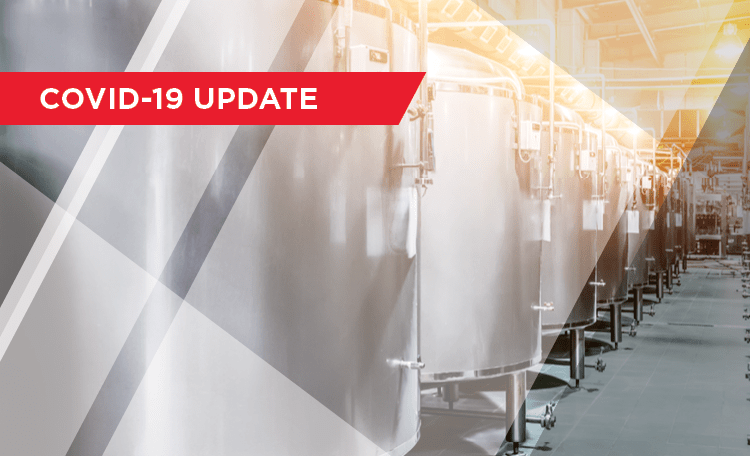
Some say the phrase ‘turn on a dime’ has been around since the 1880’s. Over time, the origin and meaning of the phrase may have been forgotten or confused, but it’s very relevant in the current COVID-19 pandemic. The most common reference is that the origin of the expression goes back to high performance cars, airplanes, and boats. The ability to turn around on the smallest of coins implies that you can turn very quickly in a very small space.1
In this time of the Coronavirus, the supply chains of many companies and industries are being asked to adapt quickly, and many are responding and meeting those challenges. There are echoes of the way manufacturing met the call for resources and capabilities during WWII. During that time, major industrial manufacturers of automobiles and other goods found ways to change their production lines and churn out products that were not a part of their core business. In 1941, more than three million cars were manufactured in the United States. Only 139 more were made during the entire war so car manufacturers could instead make fuselages, airplane engines, tanks, trucks and guns.2 Maytag temporarily stopped making washing machines, and instead produced components for military equipment.3
Modern day examples of manufacturing agility exist, and are often seen during times of natural disasters, such as hurricane or tornado recovery. A well-known example is the ongoing efforts of the beer industry to provide canned drinking water; annual production of canned water is planned for, and built into, regular production schedules so that supplies are available at any time to respond to a wide array of needs for both beer producers and the public.4
The Coronavirus Response
In early 2020, to respond to shortages, we’ve already seen LVMH (maker of Christian Dior and Givenchy cosmetics/fragrance, among other brands) move to convert production lines in some cosmetics and fragrance plants to manufacture hand sanitizer for healthcare workers in France.5 There is current conversation in several geographies and industries about the potential for auto or other equipment manufacturers to adjust their production lines to manufacture additional ventilators, which may be needed in hospitals for critical care COVID-19 patients.6 Technological advances in 3D printing may also enable additional production of important components of medical equipment, such as valves for those critical ventilators.7
Ways that Supply Chain and Industrial Real Estate Partners Can Help
Switching over manufacturing and production lines is not an overnight proposition for most products, but critical needs may be urgent, and the ability to move quickly and efficiently are a hallmark of both the supply chain and commercial real estate industries. The very nature of supply chains is that they are interconnected, as are the professionals in these industries; it is in times like this we can muster resources and connectivity to assist and support various needs in a way many sectors can’t.
- Inbound source materials may be different and may arrive from different origins/shippers: The raw materials and finished goods packaging arriving at a production plant will likely require different handling, sources, freight carriers and storage in a building not designed for those materials. The beer industry is well suited for the production of canned water because both require the same raw materials (water) and packaging (aluminum cans). In this case, switching over production is relatively easy (with a label change, of course). An automotive plant, however, may not have the necessary racking or storage to house protective shipping packaging or smaller boxes required for finished ventilators coming off of a production line. The number of dock doors and staging areas needed may also require creative adjustments to handle smaller goods than the rolled sheet metal and other components that are typically used.
- Expertise and skillsets needed may be very different: In the LVMH example, the production of cosmetics and fragrance likely requires very similar skillsets and labor to that of producing hand sanitizer. Mixing, bottling and quality control activities are likely the same or very similar to the plant’s normal production of creams or serums. As a result, workforce adjustment may require minimal retraining or skills augmentation. In the case of an auto manufacturer converting to ventilator production, however, the plant may need additional workers or skillsets for the calibration and testing of medical equipment. The upside here, is the skill required for precision medical device components may be very similar to that of complex onboard navigation devices installed in modern vehicles. Supply chain and industrial real estate professionals have wide networks of contacts in a vast array of industries and sectors that may not be as readily available to the manufacturer whose typical focus is in their core industry. A simple call for contacts or sharing of key contact information at a relevant company may work to quickly connect resources who can collaborate to meet a new skillset need.
- Outbound shipping may need different or expanded capacity and temporary building configurations: Shipping out finished ventilators from a plant that is instead well-versed in rolling off finished vehicles from a production line may present some unique challenges. The product may require a different set of trucking carriers, outbound loading procedures in very tight shipping/receiving docks not configured for parcel handling, or adjusted hours for round-the-clock movement of goods. Along with the creative solutions and network of contacts mentioned above, the industrial real estate community may also be able to assist manufacturers and distributors in quickly reaching out to key municipality and utility contacts to find ways to solve for temporary needs that the manufacturer may have.
The ways that companies are responding, and will continue to respond, to the current pandemic share some similarities with the way that supply chains and commercial real estate collaborate to meet the needs and challenges presented every year by natural disasters such as hurricanes and tornadoes. The ability and agility both industries provide are more important than ever in the current situation. Leveraging the connectivity and operational know-how that these professionals have, across a myriad of sectors, product types and industries is more important than ever.
1 https://americaexplained.wordpress.com/2011/02/03/turn-on-a-dime/
2 https://www.pbs.org/thewar/at_home_war_production.htm
3 https://en.wikipedia.org/wiki/Maytag
4 https://www.nydailynews.com/news/national/beer-companies-switch-canned-water-harvey-victims-article-1.3452701
5 https://www.cnbc.com/2020/03/15/lvmh-will-use-its-perfume-and-cosmetics-factories-to-manufacture-free-hand-sanitizer.html
6 https://www.theguardian.com/business/2020/mar/16/vauxhall-owner-psa-car-shuts-european-plants-amid-coronavirus-fears
7 https://www.fastcompany.com/90477940/these-good-samaritans-with-a-3d-printer-are-saving-lives-by-making-new-respirator-valves-for-free


